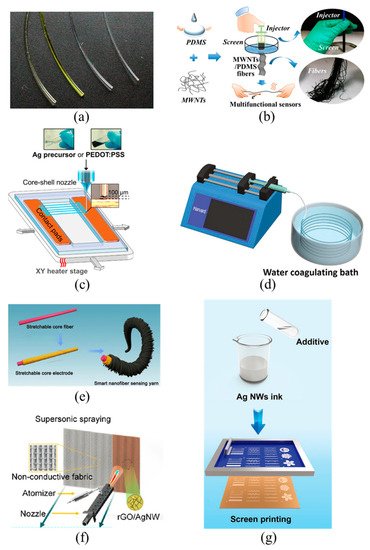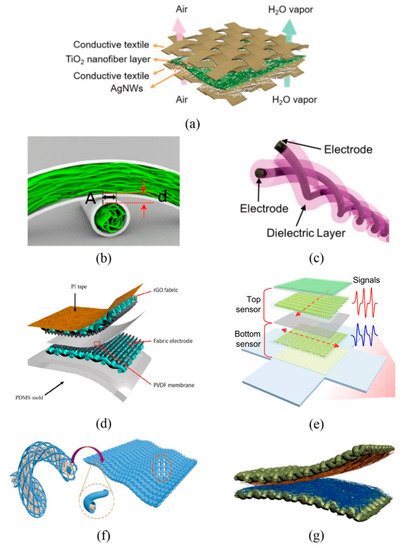Resistive TMSs convert mechanical stimuli, such as displacement or force to a resistance change, using piezoresistive materials. As the resistance of a conductive material is defined as R = ρL/S, when a mechanical stimulus causes changes of the piezoresistive materials in resistivity (ρ), length (L), and/or cross-sectional area (S), it will bring out a resistance change. The sensing response of resistive TMSs depends on the interaction of these main factors: (1) intrinsic changes in the resistance of sensing elements in response to mechanical stimuli; (2) geometric variation of assembled devices; and (3) changes in the conduction network. Based on a regression curve, the mechanical stimuli and their degrees can be determined. Because resistive TMSs often have the advantages of high sensitivity, wide detection range, high precision, and simple measurement circuits, they have received the most extensive attention and study [
32]. However, large signal drift, poor durability, and obvious hysteresis are the key issues that restrict their practical application [
33].
Resistive TMSs are typically composed of a soft substrate and a sensing material [
34]. The soft substrate needs have properties such as a certain elasticity, good flexibility, and long-term stability. These properties can provide a carrier for sensing materials, and endow the sensing materials and subsequent textiles with piezoresistive properties. They can also reduce the stress concentration of TMSs when subjected to mechanical stimuli. Commonly used substrate materials for TMSs include silk, cotton, polydimethylsiloxane (PDMS), polyurethane (PU), etc. Correspondingly, commonly used sensing materials have carbon materials, metal materials, conductive polymers, etc. The sensing materials need to be both conductive and mechanically robust, which are typically prepared by coating, depositing, winding, or electroplating functional conductive layer on fibers, yarns, or fabrics, and they can also be prepared by wet spinning or 3D printing processes. Functional fibers and yarns can be attached to complex surfaces or woven into fabrics, which makes the sensors adaptable to different application scenarios by changing their shape and can be prepared in a sustainable and large-scale way. Neves et al. [
35] produced conductive fibers by coating graphene onto polymer fibers that could be bent, stretched, compressed, twisted, and deformed into complex shapes while still maintaining good performance and reliability (
Figure 1a). These graphene-based conductive fibers can be utilized as a platform for constructing integrated electronics directly in textiles. The stretch property of the conductive coating layer is often significantly lower than that of the textile substrate, which often leads to the formation of cracks in large deformations, resulting in reduced sensing stability. Additionally, as the textile surface is coated with a relatively rigid layer of conductive material, the feel and comfort of the fabric will be different. Composite conductive fiber—fiber adding conductive materials—can maintain the characteristics of the main fiber, such as the feeling and wear resistance. The structure of composite fibers is more integrated than that of coated textiles, effectively improving the problem of micro-cracks on the surface of coated fibers. Li et al. [
36] used a syringe to extrude a mixture of conductive multiwalled carbon nanotubes (MWCNTs) and PDMS through a mesh with micron-sized holes to fabricate functional fibers (
Figure 1b). The fibers as part of a wearable sensor were then integrated into a smart glove to recognize finger dexterity, gestures, and temperature signals. This preparation method is simple and convenient, but it is not suitable for large scale preparation of functional fibers. Wang et al. [
37] used a concentric nozzle to rapidly and precisely print nanofibers with a bilayer structure (
Figure 1c). The inner layer of the nanofiber acts as a sensing layer composed of metal or conductive polymer materials, whereas the outer layer acts as a protective and supportive layer that consists of long-chain polymer materials. The smart mask made from the nanofibers by a one-step progress can be used to detect whether the mask is worn properly and whether breathing is abnormal. Additionally, traditional textile manufacturing technologies of wet spinning and electrostatic spinning are also applicable to fabricate functional fibers. Sheng et al. [
38] prepared porous fiber-based strain sensors by the wet-spinning method, wherein thermoplastic polyurethane was used as elastomer and carbon nanotubes (CNTs) and graphene as conductive fillers (
Figure 1d). Before wet-spinning, dispersants and binders were introduced to improve the interaction between the elastomer and the conductive fillers to achieve the purpose of effectively withstanding external forces. Qi et al. [
39] used a simple electrostatic spinning technique to prepare nanofiber sensing yarn, which was composed of a fibrous core electrode wrapped and wound by piezoresistive elastic nanofibers (
Figure 1e). The yarn showed a fine layered structure, and could be woven into fabrics to achieve multi-mode sensing of various mechanical stimuli.
Fabric-based mechanical sensors can also be designed and prepared by the methods of coating, deposition, inkjet printing, screen printing, etc. Among them, directly coating sensing material onto common fabrics is the simplest and easiest method to achieve large-scale TMSs preparation. However, this method will bring about a poor bond between the sensing material and the flexible fabrics, so that the stability and durability of the prepared TMSs cannot be guaranteed. Thus, how to improve the adhesion between the two materials has become the first problem to be solved in the preparation of high-performance TMSs, wherein functionalized molecular grafting sensing materials is one of the preferred methods. Liu et al. [
40] coated fluorinated MXene nanosheets onto 15 different fabrics, because the surface of the MXene is rich in a large amount of functional groups that interact with the fabric surface to improve adhesion between the two. It has been experimentally proven that the MXene formed a strongest bond with pure cotton and will not come off even after washing and ultrasonic processing. In addition, the adhesion can be enhanced by improving the preparation process of the TMSs. A multifunctional mechanical-sensitive fabric is prepared via ultrasonically spraying reduced graphene oxide (rGO) and silver nanowires (AgNWs) onto synthetic and 100% natural cotton fabrics (
Figure 1f). The obtained fabrics show a good durability and can be washed repeatedly without performance degradation [
41]. Luo et al. [
42] used simple and efficient screen printing to transfer high-performance AgNW inks onto stretchable fabrics (
Figure 1g), which presented excellent tensile properties and sensing performance. Conveniently, sensing materials with different patterns can be printed by simply changing the screen with different shapes, and fabric-based mechanical sensors prepared by printing processes can be designed into desired patterns to improve the sensing range, sensitivity, and other properties of resistive sensors. In summary, the coating and screen-printing method is easy to implement TMSs with superior sensitivity and a relatively large sensing range. However, the low linear correlation and cyclic stability of the sensing layer greatly limit its practical application.
Figure 1. Illustration of the manufacturing process of various resistive textile-based mechanical sensors (TMSs). PDMS means polydimethylsiloxane, MWNTs means multi-walled carbon nanotubes, PEDOT:PSS means poly(3,4-ethylenedioxythiophene)/poly(styrenesulfonate), rGO means reduced graphene oxide and AgNWs means silver nanowires. Fiber-based sensors prepared by (
a) coating, reproduced with permission from [
35]; (
b) extrusion, reproduced with permission from [
36]; (
c) printing, reproduced with permission from [
37]; and (
d) wet spinning, reproduced with permission from [
38]; (
e) Yarn-based sensors prepared by electrostatic spinning, reproduced with permission from [
39]; Fabric-based sensors prepared by (
f) spraying, reproduced with permission from [
41]; and (
g) screen printing, reproduced with permission from ref. [
42].


